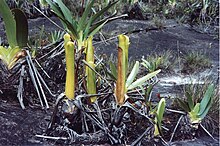bio.wikisort.org - Plant
Brocchinia reducta /brɒˈkɪniə riːˈdʌktə/ is one of a few carnivorous bromeliads. It is native to southern Venezuela, Brazil, Colombia, and Guyana, and is found in nutrient-poor soil.[1][2][3][4] B. reducta adapts to different environments, when growing on rocks it uses its roots as anchors.[5]
| Brocchinia reducta | |
|---|---|
 | |
| Brocchinia reducta on Mount Roraima | |
| Scientific classification | |
| Kingdom: | Plantae |
| Clade: | Tracheophytes |
| Clade: | Angiosperms |
| Clade: | Monocots |
| Clade: | Commelinids |
| Order: | Poales |
| Family: | Bromeliaceae |
| Genus: | Brocchinia |
| Species: | B. reducta |
| Binomial name | |
| Brocchinia reducta Baker 1882 | |
 | |
| Brocchinia reducta distribution | |
Structure
Brocchinia reducta, like many other bromeliads, forms a water-storing cup with its tightly overlapping leaves. The leaves surrounding the cup of B. reducta are coated with loose, waxy scales. These scales are highly reflective of ultraviolet light. Since many insects are attracted to ultraviolet (it is also reflected by many flowers), this is an efficient lure. The water in the cup also emits a sweet odor, which may serve to attract ants and other insects.[6] B. reducta absorbs its nutrients from the outer cell wall, which is covered in trichomes that can transport molecules as small as 6.6 nm.[7]
The loose scales provide a poor foothold for landing insects, causing them to slip into the water-filled cup and eventually drown.[8]
References
- Kew World Checklist of Selected Plant Families
- Hokche, O., Berry, P.E. & Huber, O. (eds.) (2008). Nuevo Catálogo de la Flora Vascular de Venezuela: 1-859. Fundación Instituto Botánico de Venezuela.
- Funk, V. A., P. E. Berry, S. Alexander, T. H. Hollowell & C. L. Kelloff. 2007. Checklist of the Plants of the Guiana Shield (Venezuela: Amazonas, Bolivar, Delta Amacuro; Guyana, Surinam, French Guiana). Contr. U.S. Natl. Herb. 55: 1–584
- Smith, L.B. & R. J. Downs. 1974. Pitcairnioideae (Bromeliaceae), Part I. Flora Neotropica, Monograph 14(1): 1–660
- Brown and Martin (1984). "Stigma structure and variation in Bromeliaceae—neglected taxonomic characters".
{{cite web}}: Missing or empty|url=(help) - Gonzalez, J.M.; Jaffe, K.; Michelangeli, F. (1991). "Competition for Prey Between the Carnivorous Bromeliaceae Brocchinia reducta and Sarraceniaceae Heliamphora nutans". Biotropica. 23 (4B): 602–604. doi:10.2307/2388398. JSTOR 2388398.
- thomson. "canadian journal of botany".
- Givnish, T.J.; Burkhardt, E.L.; Happel, R.E.; Weintraub, J.D. (1984). "Carnivory in the bromeliad Brocchinia reducta, with a cost/benefit model for the general restriction of carnivorous plants to sunny, moist, nutrient-poor habitats". American Naturalist. 124 (4): 479–497. doi:10.1086/284289.
Further reading
Adlassnig, W; Peroutka, M; Lendl, T (February 2011). "Traps of carnivorous pitcher plants as a habitat: composition of the fluid, biodiversity and mutualistic activities". Annals of Botany. 107 (2): 181–94. doi:10.1093/aob/mcq238. PMC 3025736. PMID 21159782.
На других языках
[de] Brocchinia reducta
Brocchinia reducta ist eine Pflanzenart aus der Gattung Brocchinia in der Familie der Bromeliengewächse (Bromeliaceae). Sie gilt als einzige fleischfressende Pflanze (karnivore Pflanze) unter den Bromelienarten. Sie ist ein Endemit südlich des Orinoko in der Gran Sabana auf den Gipfeln einiger Tepuis im südlichen Venezuela und im nordwestlichen Guyana.- [en] Brocchinia reducta
Другой контент может иметь иную лицензию. Перед использованием материалов сайта WikiSort.org внимательно изучите правила лицензирования конкретных элементов наполнения сайта.
WikiSort.org - проект по пересортировке и дополнению контента Википедии